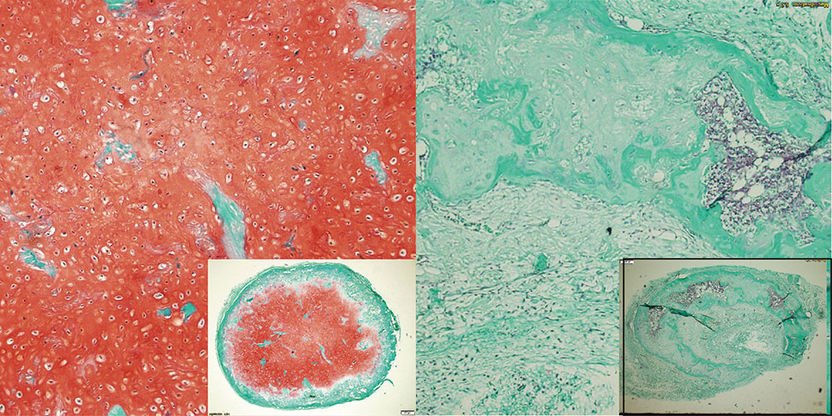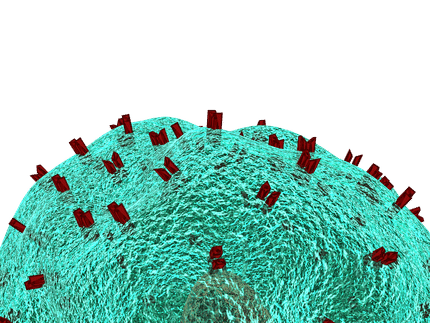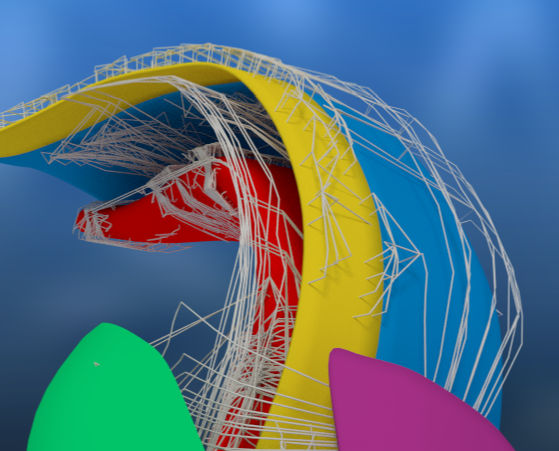Researchers succeed in cultivating cartilage from stem cells
Stable joint cartilage can be produced from adult stem cells originating from bone marrow. This is made possible by inducing specific molecular processes occurring during embryonic cartilage formation, as researchers from the University and University Hospital of Basel report in the scientific journal PNAS.

Development of cartilage tissue from mesenchymal stem/stromal cells after eight weeks in vivo: Inhibition of the signaling pathway of the protein BMP leads to the maintenance of stable cartilage tissue, indicated by red staining (left). In contrast, the control group shows a development towards bone tissue (right).
University of Basel, Department of Biomedicine
Certain mesenchymal stem/stromal cells from the bone marrow of adults are considered extremely promising for skeletal tissue regeneration. These adult stem cells usually develop into cartilage tissue which later naturally remodels into bone tissue. Even if the stem cells are induced to differentiate into cartilage cells, they spontaneously mature into a so-called “hypertrophic” state, ultimately leading to the formation of bone tissue; this is similar to the cartilaginous tissue temporarily formed after a fracture.
Inhibiting signaling pathways
Prof. Dr. Ivan Martin’s research group at the Department of Biomedicine has now been able to demonstrate that by forcing certain molecular events occurring during the embryonic development of articular cartilage it is possible to generate stable cartilage tissue from adult human mesenchymal stem cells. This can be achieved by inhibiting the signaling pathway of a specific protein (Bone Morphogenetic Protein, BMP). The Basel team generated these results after many years of cooperation with the Novartis Institutes for Biomedical Research, which produced and supplied the inhibitors.
Specifically, the scientists investigated two highly specific BMP receptor inhibitors in a special device (microfluid platform) developed in cooperation with Politecnico di Milano. With the use of this new technology, they were able to show that the temporary blocking of specific BMP receptors – even if only for a limited time – is sufficient to maintain stable cartilage tissue, both in the laboratory and in a mouse model.
Embryonic cartilage formation as a model
These results open new perspectives in the regeneration of articular cartilage as well as in the establishment of stem cell-based models of cartilage development, physiology, and possibly pathology. “Importantly, we have achieved our insights by mimicking molecular processes occurring during embryonic cartilage formation,” says Ivan Martin. This confirms the vital role of “developmental engineering,” in which natural processes are mimicked to control the development and specification of adult stem and progenitor cells.
Original publication
Most read news
Original publication
Paola Occhetta, Sebastien Pigeot, Marco Rasponi, Boris Dasen, Arne Mehrkens, Thomas Ullrich, Ina Kramer, Sabine Guth-Gundeld Andrea Barbero, and Ivan Martin; "Developmentally inspired programming of adult human mesenchymal stromal cells towards stable chondrogenesis"; PNAS; 2018
Organizations
Other news from the department science

Get the life science industry in your inbox
By submitting this form you agree that LUMITOS AG will send you the newsletter(s) selected above by email. Your data will not be passed on to third parties. Your data will be stored and processed in accordance with our data protection regulations. LUMITOS may contact you by email for the purpose of advertising or market and opinion surveys. You can revoke your consent at any time without giving reasons to LUMITOS AG, Ernst-Augustin-Str. 2, 12489 Berlin, Germany or by e-mail at revoke@lumitos.com with effect for the future. In addition, each email contains a link to unsubscribe from the corresponding newsletter.






















































